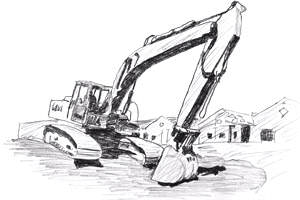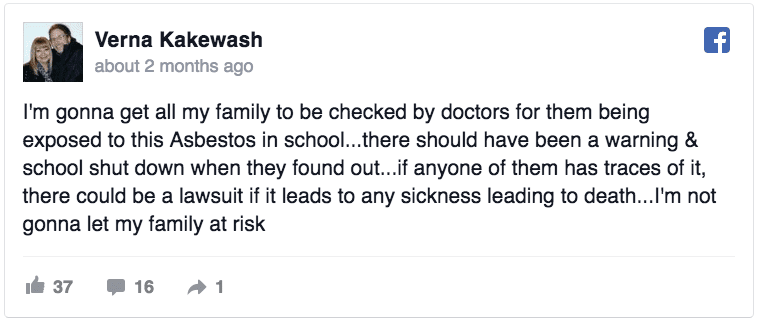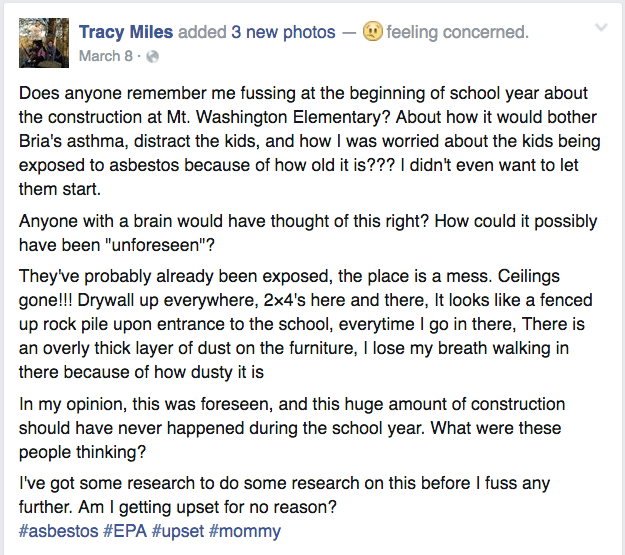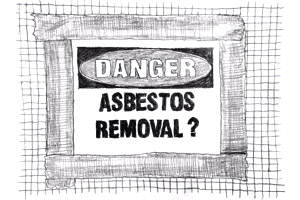How Asbestos Came to Be Widespread in School Buildings
Asbestos is one of those things people hear about, and know it’s “bad,” but don’t truly understand what it is or why it is such a problem. In fact, Jamie remembers the attitude in her asbestos-laden classroom as being “extremely lackadaisical.” She explains:
“I remember it being brushed off with a ‘nothing to see here, now move along,’ type of attitude. As if it were nothing more than a dandelion seed floating by. Being young and not really getting how serious it really was, I think we all just joked around about it. To be fair, maybe at the time the teachers weren’t entirely aware either.”
The truth is that this dangerous, cancer-causing material kills 12,000-15,000 Americans every single year. On a global level, the World Health Organization (WHO) estimates more than 107,000 deaths are attributable to exposure to asbestos at work — that number does not include the thousands of other individuals who were exposed to asbestos at home, in school, or even secondhand.

The issue of asbestos in schools has been consistent - and growing - problem in the U.S. since the Industrial Revolution during the 1800s.Source 1
An extremely effective building material that was also budget-friendly? Asbestos was every school districts dream.
Asbestos-containing products were included in the initial construction of school buildings from the 1800s until the late 1970s because the general public had no idea they were dangerous. As far as most people were concerned, there were only benefits to using asbestos in schools: it was inexpensive, naturally-occurring, easily obtained in the U.S., incredibly strong, and resistant to heat. An extremely effective building material that was also budget-friendly? Asbestos was every school districts dream.
- Cement Products
- Plaster
- Fireproof textiles
- Vinyl floor tiles
- Thermal and acoustic insulation
- Sprayed materials for fireproofing
- Pipe covering and boiler lagging
 The primary issue with asbestos is that when it becomes damaged or is disturbed in some way, its tiny fibers can come loose and be released into the air. Once asbestos fibers are freed, they can then be inhaled by anyone in the general area. In a building, like a school, they can even be swept into air ducts and circulate into other areas. When a person breathes in asbestos fibers, those fibers are akin to miniscule needles and can become lodged in the lungs, stomach, heart, or other parts of the body. They usually do not cause trouble right away — the fibers can wait in the body for decades, slowly causing devastating diseases like mesothelioma to develop.
The primary issue with asbestos is that when it becomes damaged or is disturbed in some way, its tiny fibers can come loose and be released into the air. Once asbestos fibers are freed, they can then be inhaled by anyone in the general area. In a building, like a school, they can even be swept into air ducts and circulate into other areas. When a person breathes in asbestos fibers, those fibers are akin to miniscule needles and can become lodged in the lungs, stomach, heart, or other parts of the body. They usually do not cause trouble right away — the fibers can wait in the body for decades, slowly causing devastating diseases like mesothelioma to develop.
In a 1979 report, when the true dangers of asbestos were first coming to light, the U.S. Environmental Protection Agency (EPA) detailed ways in which asbestos-containing materials can be disturbed in schools, causing fibers to be released:
- General school activities, like a ball hitting a gymnasium ceiling, or a teacher hanging posters on the wall
- Routine maintenance activities working on a fixture near a ceiling
- Vandalism, in which a material is scraped, gouged, or hit
- Water damage from roof or plumbing leaks, or burst pipes, can cause deterioration
- Vibrations in the building, possibly from machinery, activities on a floor above, or something outside the building
With so many asbestos-containing materials in schools, and a variety of ways in which they can be disturbed, it is alarming to think about how many teachers and students have been exposed over the years. And, according to the EPA and the scientific community:
“…any exposure to asbestos involves some health risk. No safe level of exposure (or threshold exposure level) has been established.”
Teachers Are Dying and Many Are Unaware of the Dangers of Asbestos Exposure
The average teacher isn’t thinking about asbestos on a regular basis. Teachers go to work every day because they have a job to do — an extremely important job — and they are usually much more concerned with educating their students rather than wondering if the building they work in contains asbestos. Many teachers also likely assume that if they are doing their jobs, the district must be doing their job to keep school buildings safe.
“I think the school I worked in was built prior to 1980 and honestly I never thought about asbestos. I thought there were laws in place requiring replacement of asbestos-based structures such as ceiling tiles,” said Jo Ann Priest, a retired high school teacher. “It certainly would be interesting to find the rate of mesothelioma in teachers. I know that teachers are constantly concerned about the environment they work in and want a safe place for students and themselves.”

Prior to 1980, asbestos was used in countless consumer products and even hailed as a "miracle mineral."
There are statistics that show teachers are at a higher risk of developing mesothelioma and other asbestos-related disease.
“Occupations associated with significantly elevated mesothelioma mortality include plumbers, pipefitters, and steamfitters; mechanical engineers; electricians; and elementary school teachers.”
It is prolonged and constant exposure to asbestos that increases an individual’s chance of developing an asbestos-related disease, and that is exactly the kind of environment most teachers find themselves in for 30+ years.
- Elizabeth Belt died from malignant mesothelioma at age 68 after pinning the artwork of children to asbestos boards for decades.
- Between 1973 and 1984, a now 70-year-old teacher worked in 2 schools that had asbestos in ceiling tiles and on wall panels. In 2013, she was diagnosed with mesothelioma.
- At age 63, Marion Potts died from mesothelioma because like Elizabeth Belt, she also used to hang her students’ artwork up on the asbestos-filled walls.
Marion Potts’ husband, Michael, spoke out about asbestos in schools after her death, saying, “You usually associate the disease with dockers or those working in industrial jobs, not teachers. These buildings are 50 years old and asbestos will come out because kids are always running around, banging into things and people stick things into the wall. She was never made aware of these dangers.”
The Cost of a Growing Problem
In a U.S. Department of Education report about the condition of America’s public school facilities, the average of the reported number of years since the construction of the main instructional building was 44 years. Forty-four years ago, asbestos-containing materials were still being widely used in the construction of schools.
As our nation’s schools age, the risk of asbestos exposure continues to grow for teachers, administration, and students alike. For many, the initial reaction may be to renovate or demolish the hazardous schools immediately and take care of the problem. However, there is one main issue holding school districts back: money.
For schools that were built before 1980, it can be challenging to say the least to keep up with the laundry list of repairs. Asbestos isn’t the only problem these educational institutions are dealing with — there are structural problems, electrical issues, mold hazards, rodent infestations, and demands to ensure the buildings are up to modern day fire code. All of these complications, coupled with the costs of daily operation, make asbestos removal an expensive obstacle for countless schools – and, sadly, just one of many.
 For some schools, the cost of keeping up with repairs eventually becomes more than the cost of a total renovation or new construction. That is what happened in Newport, Rhode Island, the city where Jamie Heller went to school. Jamie’s middle school, Thompson Middle School, where she remembers asbestos fibers falling from the ceiling, was comprised of 2 different buildings — the oldest was from 1893. In 2002, a huge renovation project was completed in which one building was completely demolished and re-built, while the outside and “bones” of the 1893 building were kept intact for historical purposes, and the interior was completely gutted and redone.
For some schools, the cost of keeping up with repairs eventually becomes more than the cost of a total renovation or new construction. That is what happened in Newport, Rhode Island, the city where Jamie Heller went to school. Jamie’s middle school, Thompson Middle School, where she remembers asbestos fibers falling from the ceiling, was comprised of 2 different buildings — the oldest was from 1893. In 2002, a huge renovation project was completed in which one building was completely demolished and re-built, while the outside and “bones” of the 1893 building were kept intact for historical purposes, and the interior was completely gutted and redone.
As an older city, Newport had to face this issue again about a decade later with the deteriorating elementary schools. They had to make the decision to sell and vacate those 5 different buildings around town, and build 1 new school building to house everyone.
“When the former schools were in use, every caution was taken to prevent the students and staff from exposure to asbestos,” said Sandra Flowers, a member of the Newport School Committee, and former public school teacher. “Any renovations and new construction come under the aegis of the RI Department of Education, which is so cautious about every step that is taken. Federal laws and guidelines must be adhered to or we would never be allowed to have anyone in the buildings.”

Prolonged and constant exposure to asbestos increases an individual's chance of developing an asbestos-related disease.
School districts with limited budgets try to cut corners or unknowingly hire poorly qualified contractors.
Trying — and Failing — to Remove Asbestos Safely from Schools
A Facebook search of “asbestos, school” shows how common this problem is because it seems like every few days, a parent is publicly voicing a concern about an asbestos scare at their child’s school.


- Haverhill, MA: A pipe burst at the Albert B. Consentino School due to cold weather and poured into the school’s library and adjacent corridor, causing the ceiling system to fail. There was asbestos fireproofing spray above the ceiling, and asbestos-containing floor tiles that delaminated from the concrete floor.
- Baltimore, MD: The community is begging for a new high school due to a few different concerns, including the presence of asbestos. The county is saying strict protocols will be followed when the asbestos is removed, but after a broken asbestos tile was found in a gym storage room, teachers and residents are not very confident that total safety is a guarantee.
- Dallas, TX: More than 250 students at South Oak Cliff High School staged a walk out to show their anger regarding the condition of their facility, which includes asbestos dangers.
- Berkeley County, SC: The Berkeley County School District had to pay more than $213,000 extra during a high school renovation project when higher-than-expected levels of asbestos were found. Asbestos had been supposedly removed from the building in 1997, but more was found in the ceiling tiles and carpet.

In the beginning half of 2015, more than 50 asbestos-relatied incidents in 13 different states had already been reported.Source 2
One school district that has been dealing with major asbestos concerns recently is in Cedar Rapids, Iowa. Between December 2014 and July 2015, contractors were hired to replace the heating and ventilation system at Washington High School. The school district was aware of the presence of asbestos and they hired Abatement Specialties, LLC to oversee the abatement. However, after receiving a tip, the state Department of Natural Resources (DNR) conducted an on-site inspection during the renovations which found higher-than-permitted asbestos levels in the building.
The DNR filed a report with the Environmental Protection Commission (EPC) accusing the Cedar Rapids school district and Abatement Specialties of:
“Failing to remove all regulated asbestos-containing materials before demolition, failing to keep the asbestos adequately wet, and failing to seal all asbestos in leak-tight containers.”
After the EPC held a meeting about the problem, representatives from Washington High School released a statement saying “many of the instances referred to in the allegations involved construction areas where students and staff were not allowed and/or at times when students and staff had been dismissed for the summer break.”
Homegrown Iowan reports workers insisted the asbestos problem was widespread and they sometimes saw students and teachers only feet away from where the project was happening. In the DNR report, one worker said that in one room, it looked like a “powder bomb” went off.
Bob Grafton, the parent of a Washington High School student, voiced his concerns about the asbestos problems at the school:
“Our child attends Washington and noticed and commented during that time that you could see foot prints in the halls from dust. Also, dust covered the lockers throughout the day with the students writing onto the surfaces. This all took place while the school was in session and the last two weeks of the school year prior to summer break.
Just remember, air handlers move air and push conditioned air to different areas for comfort using the venting system. The dust travels with the air and deposits into the public spaces. General filter systems cannot capture the small fine dust. I doubt the workers did not have the common sense to consider the air intake in that room during their failed protocol to protect the public.”
Complacency and Laziness in State Governments
While some states acknowledge asbestos problems in their school buildings and take (not always successful) steps toward removal, some states are completely ignoring the problem.
Twenty states responded to the inquiry, while the remaining 30 states ignored their request entirely. In their report about the findings, Failing the Grade: Asbestos in America’s Schools, the senators said they found:
- The scope of asbestos hazards in the U.S. is likely widespread, but remains difficult to ascertain.
- States do not appear to be systematically monitoring, investigating, or addressing asbestos hazards in schools.
- States do not report conducting regular inspections of local education agencies to detect asbestos hazards and enforce compliance.
- States do not report record-keeping activities intended to keep track of asbestos hazard information or remediation activities in schools.
Without federal or state governments enforcing AHERA, many school districts are opting to look the other way, play dumb, and pray they won’t have to shell out money to address any lurking asbestos in their buildings.
The Effects of Ignoring a Dangerous Problem
As Jamie spoke about her experience with asbestos exposure in middle school, it was obvious that at the time, neither she, her classmates, nor her teacher, really seemed to understand how dangerous this substance could be. The general public had no idea how deadly asbestos could be until around 1980, and even when Jamie was exposed in the mid-90s, the hazards were not totally understood. So, many people chose to ignore the problem.
 At its core, this issue was not caused by the individuals who ran our country’s schools. It was the companies who manufactured asbestos-containing products that knew about the dangers long ago and chose to keep them secret. When these schools were constructed, those involved were under the impression that they were using safe materials that could not harm teachers or students. Now, because those corporations chose to put profits ahead of people, our country’s educational institutions are forced to deal with the repercussions.
At its core, this issue was not caused by the individuals who ran our country’s schools. It was the companies who manufactured asbestos-containing products that knew about the dangers long ago and chose to keep them secret. When these schools were constructed, those involved were under the impression that they were using safe materials that could not harm teachers or students. Now, because those corporations chose to put profits ahead of people, our country’s educational institutions are forced to deal with the repercussions.
It doesn’t seem very fair, does it? However, now that we know about the health dangers associated with asbestos, and many school districts are not doing what they need to do to create a safe learning environment, they are ultimately no better than the companies who sold asbestos-containing products.
School teachers are dying. They were exposed to asbestos on a daily basis and now, in their retirement, are being diagnosed with mesothelioma and other asbestos-related diseases . The men and women who have dedicated their lives to educating our children should not also have to sacrifice their health. Likewise, school should be a safe learning environment in every sense of the word — parents should not have to send their children to an asbestos-filled building every day of the week in order for children to receive an education.
Now, as the mother of 2 children, and 20 years after her own encounters with asbestos in schools, Jamie has had to make important decisions about how her kids will be educated.
“Ultimately, my husband and I have decided to send our kids to private school in the fall, due to our experience with crumbling structures and the apparent lack of funding that goes into maintaining the public schools,” explained Jamie. “Don’t get me wrong — there were other factors at-play in coming to this decision — but kids should feel enriched and inspired by their surroundings. They shouldn’t have to worry about asbestos and all the health risks that come along with it.”

The Asbestos Hazard Emergency Response Act (AHERA), signed into law in 1986, requires EPA to put regulations onto educational agencies to prevent or reduce asbestos hazards.